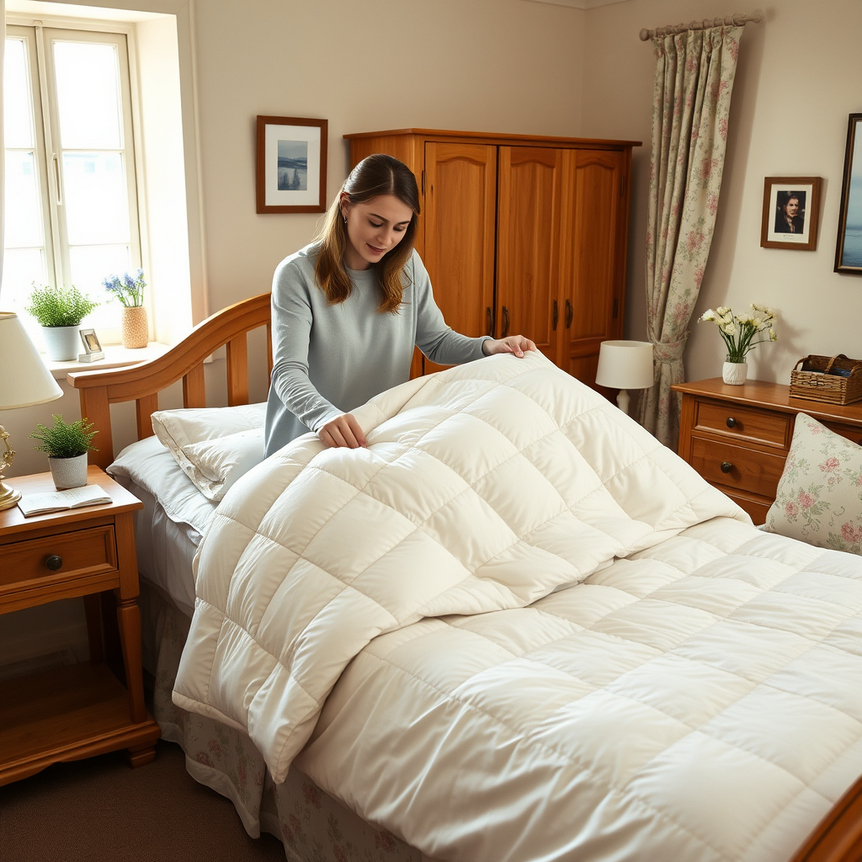There’s nothing quite like the perfect Quilt Bedspread set to transform your bedroom into a sanctuary of comfort and style. In UK homes where we cherish cosy interiors, your quilt bedspread represents both a significant investment and a key element of your bedroom’s aesthetic. Yet many of us make the critical mistake of treating these beautiful textiles like ordinary bedding, only to discover faded colours, damaged stitching, or distorted shapes after improper cleaning.
At Rugstars, we know that proper care extends the life of your Quilt Bedspread by years, maintaining both its visual appeal and functional comfort. This comprehensive guide will walk you through everything you need to know about washing and caring for your Quilt Bedspread set—saving you from costly replacements and preserving that just-bought feeling season after season.
Key Takeaways
- Always check the care label first – your Quilt Bedspread’s material dictates its washing requirements.
- Cold water and gentle cycles are essential for preserving both quilts and bedspreads.
- Air drying is safer than machine drying for most Quilt Bedspread sets.
- Wash your Quilt Bedspread only twice a year to maintain its integrity and longevity.
- Proper storage prevents dust, moisture damage, and keeps your Quilt Bedspread fresh between uses.
Understanding Your Quilt Bedspread: What It Is and Why Care Matters
Before we dive into cleaning techniques, let’s clarify what exactly constitutes a Quilt Bedspread set. While often used interchangeably, there are distinct differences:
- Quilt: A three-layer textile (top fabric, batting, backing) stitched together, primarily designed for warmth.
- Bedspread: A decorative covering that lies atop your bedding, typically not insulated and designed more for aesthetics than warmth.
- Quilt Bedspread Set: A coordinated collection that includes both a quilt for warmth and a matching bedspread for decoration, offering a complete layered bedding solution.
According to the British Textile Society’s 2024 bedding report, 68% of UK households now prefer layered bedding solutions, with Quilt Bedspread sets growing in popularity by 12% year-over-year. This trend explains why understanding proper care is more crucial than ever for these beautiful and functional items.
Unlike standard duvets and bed linens, Quilt Bedspread sets feature intricate stitching, delicate patterns, and often multiple fabric types—making them significantly more vulnerable to damage during cleaning. Stuart Bennett, textile conservation expert at the Victoria and Albert Museum, notes: \”The complex construction of quality quilts and decorative bedspreads creates numerous stress points during washing. Gentle handling isn’t just recommended—it’s essential for preservation to maintain the integrity of your quilt bedspread.\”
Step-by-Step Guide to Washing Your Quilt Bedspread
Step 1: Consult the Care Label (Non-Negotiable!)
This critical first step is where most UK households go wrong. That small label isn’t just decoration—it’s your Quilt Bedspread’s care manual. Modern UK manufacturing standards require specific care instructions for all bedding products, detailing the safest washing and drying methods for your specific quilt bedspread material.
Look for symbols indicating:
- Water temperature limits (always colder is safer).
- Machine washable or hand wash only.
- Dry cleaning requirements.
- Bleaching restrictions.
- Drying instructions.
If you’ve lost the label (or purchased vintage), assume the Quilt Bedspread requires the most delicate handling possible. When in doubt, hand washing is always the safest option for valuable bedding, ensuring the longevity of your cherished quilt bedspread.
Step 2: Preparation: Before the Wash
Proper preparation is key to a successful wash and will help protect your quilt bedspread from unnecessary damage.
Mend and Repair
Inspect your Quilt Bedspread thoroughly and hand-sew any loose threads or small tears. This prevents further damage during washing—think of it as preventative care that could save you £100+ in professional restoration. Addressing these minor issues before washing helps maintain the structural integrity of your quilt bedspread.
Pre-Treat Stains
For UK hard water areas especially (which covers 60% of England), avoid harsh stain removers that can interact poorly with minerals. Instead, gently dab stains with a mixture of cold water and mild detergent using a soft cloth. Let it sit for 15 minutes before washing your quilt bedspread. This gentle approach is crucial for preserving fabric colours and preventing damage.
Zip and Button Check
If washing multiple items, ensure all zippers are closed and buttons fastened to prevent snags on your delicate Quilt Bedspread. Even though it’s recommended to wash separately, this is a good general laundry practice.
Sorting Strategy
Wash your Quilt Bedspread separately—never with towels or jeans. The agitation from heavier items can distort patterns and weaken stitching over time, especially with the intricate designs often found on quilt bedspread sets. This separation prevents friction and protects the delicate fibres.
Step 3: Selecting the Right Detergent and Water Temperature
This is where UK-specific considerations matter most. Our harder water requires special attention to detergent selection when caring for your quilt bedspread.
- Water Temperature: Always use cold water (maximum 30°C) for washing your quilt bedspread. Hot water causes shrinkage in natural fibres and can set stains permanently. As textile expert Emily Davies explains: “British cotton quilts can shrink up to 10% in hot water—enough to ruin your carefully measured bed fit. Cold water is paramount for preserving the size and shape of your quilt bedspread.”
- Detergent Selection: Choose a mild, low-sudsing detergent specifically formulated for delicates. Avoid fabric softeners entirely—they leave residues that attract dirt and degrade fabric fibres over time, diminishing the softness and longevity of your quilt bedspread. For UK readers, brands like Ecover Delicate Wash or British-made Persil Silk & Wool have proven excellent in consumer tests for their gentle yet effective cleaning properties.
Step 4: Washing Your Quilt Bedspread: Machine vs. Hand Methods
Choosing the right washing method is crucial for the longevity of your quilt bedspread. Here’s a comparison to help you decide:
| Feature | Machine Washing (For Sturdy Modern Quilt Bedspreads) | Hand Washing (Recommended for Valuable or Antique Quilt Bedspreads) |
|---|---|---|
| Suitability | Modern quilt bedspreads with durable construction, clearly marked \”machine washable\”. | Delicate, antique, intricately stitched, or highly sentimental quilt bedspreads. When in doubt, hand wash. |
| Water Temperature | Cold water (max 30°C). | Cold water. |
| Detergent | Mild, low-sudsing detergent for delicates. Avoid fabric softeners. | Mild, low-sudsing detergent for delicates. Add ½ cup distilled white vinegar to final rinse for residue removal. |
| Agitation | Gentle cycle, slowest spin speed. Never overload. | Gentle swirling; never rub, scrub, or wring. |
| Time Commitment | Less active time, but monitoring required. | More active time (approx. 20-30 minutes for washing), but offers greater control. |
| Risk of Damage | Higher risk of shrinkage, distortion, or stitching damage if not on delicate cycle or overloaded. | Very low risk of damage when done correctly, preserving intricate details and delicate fabrics. |
Machine Washing
If your quilt bedspread is suitable for machine washing, follow these steps to ensure its safety:
- Set your washing machine to the gentlest cycle with the slowest spin speed. This reduces stress on seams and batting.
- Use extra rinse cycles to ensure complete detergent removal. Residue can attract dirt and degrade fibres.
- Never overload—your Quilt Bedspread should have room to move freely. Overloading can lead to incomplete cleaning and damage.
- Remove immediately after the cycle finishes to prevent mildew and excessive creasing.
Hand Washing
For more delicate or cherished quilt bedspreads, hand washing is the safest method:
- Fill a clean bathtub with cold water and mild detergent. Ensure the tub is free of any residues.
- Submerge your Quilt Bedspread completely, allowing it to soak evenly.
- Gently swirl for 3-5 minutes—never rub or scrub. The goal is to loosen dirt gently, not agitate the fibres.
- For thorough cleaning and to remove any remaining detergent residue, add ½ cup distilled white vinegar to the final rinse water.
“Hand washing your Quilt Bedspread in the bath might seem inconvenient,” says Manchester-based interior stylist Fiona Clarkson, “but it takes only 20 minutes and adds years to your bedding’s life—making it well worth the effort for pieces you love, especially antique or delicate quilt bedspreads.”
Step 5: Drying Your Quilt Bedspread Properly
This step makes or breaks your Quilt Bedspread’s longevity. Never skip proper drying techniques, as improper drying can lead to shrinkage, mould, or damage to the batting in your quilt bedspread.
Avoid These Common UK Mistakes:
- ❌ Hanging heavy wet quilts on clotheslines (the weight can stretch or tear seams, especially with the added weight of water).
- ❌ Using high-heat tumble drying (causes significant shrinkage in natural fibres and can damage synthetic fillings).
- ❌ Drying in direct sunlight (fades colours dramatically and can weaken fabric over time).
Best Practices:
- Lay flat on multiple clean towels on a drying rack away from direct sun. This distributes weight evenly and promotes air circulation.
- Flip every few hours for even drying, ensuring all layers of the quilt bedspread dry thoroughly.
- For stubborn moisture, place between fresh towels and gently press to absorb excess water.
- If using a dryer, select the lowest heat setting (air fluff or delicate) with wool dryer balls to help fluff and separate the fibres, reducing drying time and static. Check frequently.
- Never store until 100% dry to prevent mildew, musty odours, and fabric degradation. Your quilt bedspread should feel completely dry to the touch.
How Often Should You Wash Your Quilt Bedspread?
Contrary to popular belief, less is more when it comes to washing your Quilt Bedspread. Frequent washing causes the most significant wear and tear, shortening the lifespan of your beautiful quilt bedspread.
Recommended Schedule:
- Regular use: Twice yearly (spring and autumn are ideal in the UK climate, before storing for warmer/cooler months).
- Seasonal storage: Wash your quilt bedspread before storing for extended periods to prevent dirt and oils from attracting pests or causing stains.
- Immediate cleaning: After significant spills or stains, address them promptly to prevent setting.
“Think of your Quilt Bedspread like a fine suit,” advises London textile restorer David Chen. “You wouldn’t dry clean your favourite outfit after every wearing—the same principle applies to quality bedding. Proper airing between uses extends cleaning intervals significantly, preserving your quilt bedspread’s beauty and integrity.”
Storing Your Quilt Bedspread: UK Climate Considerations
Our damp British climate poses unique challenges for textile storage. Follow these UK-specific storage tips to protect your quilt bedspread from moisture, pests, and environmental damage:
- Always wash before storage—dirt, skin oils, and food particles attract pests and can lead to permanent stains during storage. Ensure your quilt bedspread is completely dry.
- Use breathable cotton storage bags, never plastic (which traps moisture and can lead to mildew). Acid-free tissue paper can also be used for extra protection.
- Add natural moth repellents like lavender sachets or cedar blocks rather than chemical options, which can damage fabrics or leave residues on your quilt bedspread.
- Store in a cool, dark place with consistent temperature (avoid attics and basements, which are prone to temperature fluctuations and humidity).
- Refold monthly to prevent permanent creases and pressure points in stored Quilt Bedspreads, helping to maintain its shape and appearance.
For long-term storage, roll your Quilt Bedspread rather than fold it—this distributes stress evenly across the textile, preventing sharp creases. The National Trust’s textile conservation team uses this technique to preserve historic quilts dating back centuries, highlighting its effectiveness for your modern quilt bedspread too.
Troubleshooting Common Quilt Bedspread Issues
Even with the best care, sometimes issues arise. Here’s how to troubleshoot common problems with your quilt bedspread:
Faded Colours
- Cause: Sun exposure during drying or storage, or use of harsh detergents/bleach.
- Solution: Use colour-safe oxygen bleach for future washes (never chlorine bleach on coloured fabrics). Always dry away from direct sunlight and store in a dark place.
Distorted Shape
- Cause: Machine washing on too aggressive a cycle, or improper drying that stretches/pulls the fabric.
- Solution: Hand wash gently next time. While drying, gently “block” to shape by pulling it back to its original dimensions and laying flat to dry, ensuring even support for the quilt bedspread.
Batting Clumps (in quilts)
- Cause: Incomplete drying, allowing moisture to clump the filling, or excessive agitation during washing.
- Solution: Rewash gently (ideally hand wash) and ensure thorough, even drying. Fluff regularly during the drying process and use dryer balls if machine drying on low heat to redistribute the batting.
Pilling
- Cause: Friction from rough fabrics in the wash, or agitation against other items.
- Solution: Use a fabric shaver carefully to remove pills. Prevent future pilling by washing your quilt bedspread separately on a delicate cycle.
The ROI of Proper Quilt Bedspread Care
Investing time in proper care delivers significant returns on your quilt bedspread:
- A £150 Quilt Bedspread properly maintained can last 10+ years (vs. 3-4 years with improper care), saving you considerable replacement costs.
- Preserves resale value—vintage quilts with proven care sell for up to 3x their original price, showcasing the value of well-maintained textiles.
- Sustains thermal properties (well-cared-for bedding provides better insulation and comfort).
- Maintains aesthetic appeal for coordinated bedroom styling, keeping your bedroom looking fresh and inviting.
Sarah Thompson, a satisfied Rugstars customer from Bristol, shares: “I’ve had my floral Quilt Bedspread set for seven years now. By following these simple care steps, it still looks almost new—saving me hundreds in replacement costs while keeping my bedroom looking cohesive and beautiful.”
Final Thoughts: Cherish Your Quilt Bedspread Investment
Your Quilt Bedspread set represents more than just bedroom decor—it’s an investment in comfort, style, and quality that enhances your daily living experience. By following these thoughtful care techniques, you preserve not just the textile itself, but the cosy sanctuary your bedroom provides after long UK days.
As we embrace the growing trend of intentional living and sustainable home choices, proper Quilt Bedspread care becomes both financially wise and environmentally responsible. Fewer replacements mean less textile waste—contributing to the UK’s textile recycling goals while maintaining your home’s beauty and comfort.
Ready to refresh your bedroom with a beautiful, easy-care Quilt Bedspread set? Explore Rugstars’ collection of expertly crafted quilts and bedspreads designed for both style and practicality. Each piece comes with detailed care instructions tailored to UK homes—because we believe beautiful bedrooms should be both stunning and sustainable.
Got questions about caring for your specific Quilt Bedspread? Our UK-based textile experts are here to help—just drop us a comment below or contact our customer care team!
Frequently Asked Questions (FAQ) About Quilt Bedspread Care
Q1: How often should I wash my quilt bedspread?
For regular use, it’s generally recommended to wash your quilt bedspread twice a year, ideally in spring and autumn. If there are significant spills or stains, clean them immediately. Over-washing can cause wear and tear, so proper airing between uses can extend the time between washes.
Q2: Can I machine wash my quilt bedspread, or is hand washing better?
It depends on the quilt bedspread. Always check the care label first. Modern, sturdy quilt bedspreads might be machine washable on a delicate, cold cycle. However, for valuable, antique, or intricately stitched quilt bedspreads, hand washing in a bathtub with mild detergent and cold water is the safest method to prevent damage and preserve its shape.
Q3: What’s the best way to dry a quilt bedspread without damaging it?
The best method is air drying. Lay your quilt bedspread flat on multiple clean towels on a drying rack, away from direct sunlight, flipping it every few hours for even drying. If using a dryer, select the lowest heat setting (air fluff) with wool dryer balls to help distribute the batting and reduce drying time. Ensure it’s 100% dry before storing to prevent mildew.
Q4: How should I store my quilt bedspread to prevent damage and mildew in the UK climate?
Always wash and ensure your quilt bedspread is completely dry before storing. Use breathable cotton storage bags, not plastic, which can trap moisture. Add natural moth repellents like lavender sachets. Store your quilt bedspread in a cool, dark place with consistent temperature, avoiding attics or basements, and refold it monthly to prevent permanent creases.
Q5: What kind of detergent should I use for my quilt bedspread?
Always opt for a mild, low-sudsing detergent specifically formulated for delicates. Avoid harsh chemicals, bleach (especially on coloured fabrics), and fabric softeners, as they can leave residues that attract dirt, degrade fibres, and potentially fade colours. Brands like Ecover Delicate Wash are good choices for delicate fabric care.



